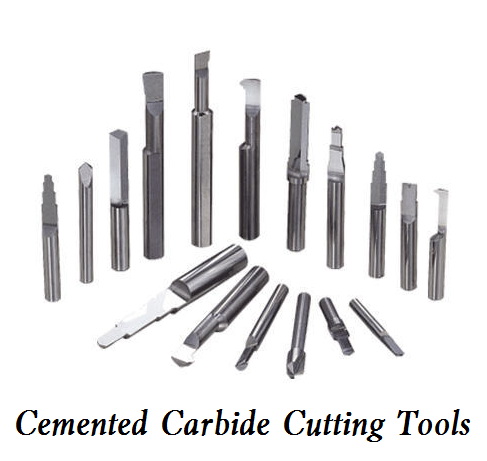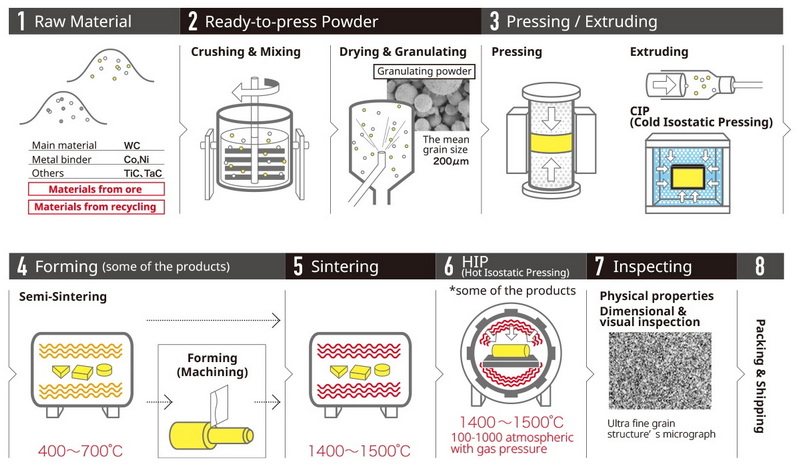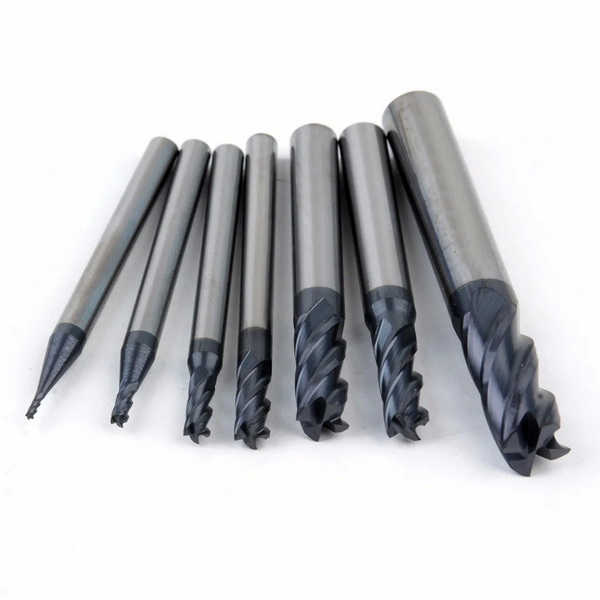Content Menu
● Introduction
● What is Anodizing?
>> Types of Anodizing
● The Process of Anodizing Tungsten Carbide
>> Step 1: Material Selection and Preparation
>> Step 2: Electrolyte Selection and Setup
>> Step 3: Applying Current and Monitoring Process Parameters
>> Step 4: Post-Treatment and Polishing
● Benefits of Anodizing Tungsten Carbide
● Challenges in Anodizing Tungsten Carbide
● Applications of Anodized Tungsten Carbide
● Future Trends in Anodizing Tungsten Carbide
● Conclusion
● FAQ
>> 1. What materials can be anodized besides aluminum?
>> 2. How thick can the anodized layer on tungsten carbide be?
>> 3. Does anodizing affect the hardness of tungsten carbide?
>> 4. Can anodized tungsten carbide be dyed?
>> 5. What are common applications for anodized tungsten carbide?
● Citations:
Introduction
Tungsten carbide (WC) is a robust material celebrated for its exceptional hardness, wear resistance, and high melting point. These properties make it indispensable in industries ranging from machining and mining to aerospace and electronics. Its ability to maintain structural integrity under extreme conditions has cemented its status as a go-to material for cutting tools, drill bits, wear parts, and high-performance components. However, despite its impressive attributes, tungsten carbide can sometimes benefit from surface modifications to further enhance its performance and lifespan. Anodizing, a surface treatment typically associated with aluminum, has emerged as a potential method for modifying the surface properties of tungsten carbide, improving its polishability, corrosion resistance, and overall durability.
This article delves into the feasibility of using tungsten carbide for anodizing, exploring the intricacies of the process, the effects on the material, and the potential advantages for various applications. We will also address the challenges and considerations associated with anodizing tungsten carbide, providing a comprehensive understanding of this emerging technique.

What is Anodizing?
Anodizing is an electrochemical passivation process that converts the metal surface into a stable oxide layer. This layer is typically formed on metals like aluminum, titanium, and magnesium to enhance their corrosion resistance, increase surface hardness, improve aesthetics, and provide a base for subsequent coating or painting. The process involves immersing the metal in an electrolytic solution and passing an electric current through it, with the metal acting as the anode (positive electrode). The electrochemical reaction at the surface leads to the formation of a protective oxide layer.
Types of Anodizing
1. Hard Anodizing: This type of anodizing produces a very thick and dense oxide layer, providing exceptional wear and abrasion resistance. It is often used for components subjected to heavy use or harsh environments.
2. Sulfuric Acid Anodizing: The most common type of anodizing, sulfuric acid anodizing creates a porous oxide layer that can be easily dyed, allowing for a wide range of colors and aesthetic finishes.
3. Chromic Acid Anodizing: This method produces a thin, corrosion-resistant oxide layer that is often used in aerospace applications.
4. Boric/Sulfuric Acid Anodizing: This process combines elements from both boric and sulfuric acids to create a unique oxide layer that offers a balance of corrosion resistance and adhesion properties.
5. Plasma Electrolytic Oxidation (PEO): Also known as micro-arc oxidation (MAO), this advanced technique can be applied to a wider range of metals, including tungsten carbide, and results in a hard, dense, and highly adherent oxide layer.
The Process of Anodizing Tungsten Carbide
Anodizing tungsten carbide requires a specialized approach due to its unique material properties and chemical inertness. While the fundamental principles of anodizing remain the same, the specific parameters, electrolyte composition, and process control differ significantly from those used for aluminum or other common metals.
Step 1: Material Selection and Preparation
Choosing the right grade of tungsten carbide is crucial, as its composition and microstructure can significantly affect the anodizing process. Typically, tungsten carbide consists of WC grains bonded together by a metallic binder, usually cobalt. The percentage of cobalt influences the material's hardness, toughness, and corrosion resistance.
Prior to anodizing, the tungsten carbide parts must be meticulously cleaned to remove any surface contaminants, such as oil, grease, dirt, or machining residues. Effective cleaning methods include ultrasonic cleaning, solvent degreasing, and alkaline cleaning, ensuring that the surface is free of impurities that could interfere with the anodizing process.
Step 2: Electrolyte Selection and Setup
The choice of electrolyte is critical for successful anodizing of tungsten carbide. Unlike aluminum, which is commonly anodized in sulfuric acid, tungsten carbide requires more aggressive electrolytes to initiate oxidation. Common electrolytes used for tungsten carbide anodizing include alkaline solutions (e.g., sodium hydroxide, potassium hydroxide) or acidic solutions containing hydrofluoric acid or other fluoride compounds.
The anodizing setup involves placing the tungsten carbide part as the anode in an electrochemical cell, with a cathode made from an inert material like stainless steel or platinum. The electrolyte solution is circulated through the cell to maintain consistent temperature and composition.
Step 3: Applying Current and Monitoring Process Parameters
During anodizing, a carefully controlled electric current is applied to the electrochemical cell. The current density, voltage, and electrolyte temperature are critical parameters that must be precisely monitored and adjusted to achieve the desired oxide layer properties. The voltage is typically ramped up gradually to prevent excessive heat generation or arcing, which can damage the tungsten carbide surface.
The oxidation process leads to the formation of an oxide layer primarily composed of tungsten trioxide (WO3) and cobalt oxide (CoO), depending on the composition of the tungsten carbide material. The thickness and composition of the oxide layer can be controlled by adjusting the anodizing parameters, such as current density, voltage, and process duration.
Step 4: Post-Treatment and Polishing
After anodizing, the tungsten carbide parts undergo post-treatment to enhance the properties of the oxide layer. This may include sealing the oxide layer to improve corrosion resistance, applying a protective coating to increase wear resistance, or performing a polishing step to achieve a smooth surface finish.
Polishing is often carried out using soft abrasives, such as silica slurry or diamond paste, to remove the oxidized layer and refine the surface. The two-step process of anodizing followed by polishing has been shown to be highly effective in enhancing the surface quality of tungsten carbide components.

Benefits of Anodizing Tungsten Carbide
1. Improved Surface Finish: Anodizing can significantly improve the surface finish of tungsten carbide parts by creating a smoother, more uniform surface.
2. Increased Corrosion Resistance: The anodized layer provides additional protection against corrosion, particularly in harsh chemical environments.
3. Enhanced Wear Resistance: Certain types of anodized layers, such as those produced by PEO, can increase wear resistance, extending the lifespan of components subjected to abrasive conditions.
4. Enhanced Adhesion Properties: The anodized layer can improve the adhesion of coatings or lubricants to the tungsten carbide surface, enhancing their performance and durability.
5. Aesthetic Customization: The porous nature of some anodized layers allows for dyeing, enabling aesthetic customization of tungsten carbide parts.
Challenges in Anodizing Tungsten Carbide
While anodizing offers numerous potential benefits for tungsten carbide surfaces, several challenges must be addressed to ensure successful implementation:
1. Achieving Uniform Oxide Layer Thickness: Ensuring that the oxide layer has uniform thickness across the entire surface of the tungsten carbide part can be difficult, particularly for complex geometries.
2. Adhesion Issues: Ensuring that the anodized layer adheres well to the tungsten carbide substrate requires careful control of processing parameters, such as electrolyte composition, current density, and temperature.
3. Cost Considerations: The anodizing process can be more expensive compared to traditional surface treatments, such as grinding or polishing, due to the specialized equipment and expertise required.
4. Material Degradation: Over-anodizing can lead to material degradation, compromising the mechanical integrity of the tungsten carbide part. Therefore, precise control of the anodizing parameters is essential to prevent damage.
5. Environmental Concerns: Some electrolytes used in the anodizing of tungsten carbide, such as those containing hydrofluoric acid, can pose environmental concerns. Therefore, proper waste disposal and environmental management practices must be implemented.
Applications of Anodized Tungsten Carbide
Anodized tungsten carbide has potential applications in various industries:
1. Cutting Tools: Anodizing can improve the performance and lifespan of cutting tools by enhancing their wear resistance and reducing friction.
2. Wear Parts: Anodized tungsten carbide can be used for wear parts in machinery and equipment, providing increased durability and resistance to abrasion.
3. Medical Implants: Anodizing can improve the biocompatibility of tungsten carbide, making it suitable for use in medical implants and surgical instruments.
4. Electronics: Anodized tungsten carbide can be used as a substrate for electronic components, providing enhanced corrosion resistance and thermal stability.
5. Aerospace: Anodized tungsten carbide can be used in aerospace components, providing increased wear resistance and corrosion protection in demanding environments.
Future Trends in Anodizing Tungsten Carbide
The field of anodizing tungsten carbide is continually evolving, with ongoing research and development efforts focused on:
1. Optimizing Electrolyte Composition: Researchers are exploring new electrolyte formulations that can enhance the anodizing process, improve oxide layer properties, and reduce environmental impact.
2. Developing Advanced Anodizing Techniques: Advanced anodizing techniques, such as PEO, are being refined to produce harder, denser, and more adherent oxide layers on tungsten carbide.
3. Exploring Nanomaterials: The incorporation of nanomaterials into the electrolyte or oxide layer is being investigated to further enhance the properties of anodized tungsten carbide.
4. Improving Process Control: Advanced process control systems are being developed to precisely monitor and adjust anodizing parameters, ensuring consistent and high-quality results.
5. Expanding Applications: Researchers are actively exploring new applications for anodized tungsten carbide in various industries, capitalizing on its unique combination of properties.
Conclusion
The use of tungsten carbide for anodizing represents a promising avenue for enhancing its properties and expanding its applications across various industries. By employing a carefully controlled electrochemical process, manufacturers can create a protective oxide layer on the tungsten carbide surface, resulting in improved surface finish, increased corrosion resistance, enhanced wear resistance, and improved adhesion properties.
While challenges remain in achieving uniform oxide layer thickness, ensuring adhesion, and managing costs, ongoing research and development efforts are continually addressing these issues. Advanced anodizing techniques, optimized electrolyte compositions, and improved process control systems are paving the way for wider adoption of anodized tungsten carbide in demanding applications.
As the demand for high-performance materials continues to grow, anodized tungsten carbide is poised to play an increasingly important role in industries requiring exceptional durability, wear resistance, and corrosion protection. By embracing this innovative surface treatment, manufacturers can unlock the full potential of tungsten carbide and create components that perform reliably even in the most challenging environments.

FAQ
1. What materials can be anodized besides aluminum?
Anodizing can also be applied to metals like titanium, magnesium, and certain alloys including tungsten carbide under specific conditions.
2. How thick can the anodized layer on tungsten carbide be?
The thickness of an anodized layer on tungsten carbide can vary but typically ranges from a few micrometers up to several tens of micrometers depending on processing conditions.
3. Does anodizing affect the hardness of tungsten carbide?
Yes, anodizing softens the surface of tungsten carbide by forming an oxide layer that is less hard than the underlying material.
4. Can anodized tungsten carbide be dyed?
Yes, certain types of anodized layers are porous enough to absorb dyes, allowing for aesthetic customization.
5. What are common applications for anodized tungsten carbide?
Anodized tungsten carbide is commonly used in cutting tools, wear-resistant coatings, and components in harsh environments where enhanced corrosion resistance is required.
Citations:
[1] https://dr.ntu.edu.sg/bitstream/10356/85206/1/Polishing%20of%20Tungsten%20Carbide.pdf
[2] https://www.finishing.com/106/69.shtml
[3] https://www.researchgate.net/publication/319865483_Polishing_of_Tungsten_Carbide_by_Combination_of_Anodizing_and_Silica_Slurry_Polishing
[4] https://dl.asminternational.org/itsc/article/doi/10.31399/asm.cp.itsc1999p0468/18861/Fatigue-Life-of-HVOF-Tungsten-Carbide-Coated
[5] https://dr.ntu.edu.sg/handle/10356/85206
[6] https://www.pfonline.com/articles/plating-carbide-parts
[7] https://knowledge.electrochem.org/encycl/art-a02-anodizing.htm
















